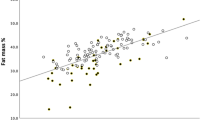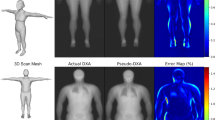Abstract
Background:
The measurement of adipose tissue (AT) depots in vivo requires expensive imaging methods not accessible to most clinicians and researchers. The study aim was to derive mathematical models to predict total AT (TAT) and subdepots from total body fat derived from a dual-energy X-ray absorptiometry (DXA) scan.
Methods:
Models were developed to predict magnetic resonance imaging–derived TAT and subdepots subcutaneous AT, visceral AT, and intermuscular AT from DXA total body fat (FatDXA) using cross-sectional data (time 0 (T0)) and validated results using 1 (T1) and 2 (T2) y follow-up data. Subjects were 176 multiethnic healthy children ages 5–17 y at T0. Twenty-two were measured at T1 and T2. TAT was compared with FatDXA.
Results:
At T0, TAT was greater than FatDXA (12.5 ± 8.4 vs.12.0 ± 9.4 kg; P < 0.0001), with a quadratic relationship between TAT and FatDXA that varied by sex. Predicted mean TATs were not different from measured TATs: T1: (9.84 ± 4.45 kg vs. 9.50 ± 4.37 kg; P = 0.11); T2: (12.94 ± 6.75 kg vs. 12.89 ± 7.09 kg; P = 0.76). The quadratic relationship was not influenced by race or age.
Conclusion:
In general, the prediction equations for TAT and subdepots were consistent with the measured values using T1 and T2 data.
Similar content being viewed by others
Log in or create a free account to read this content
Gain free access to this article, as well as selected content from this journal and more on nature.com
or
References
de Onis M, Blössner M, Borghi E . Global prevalence and trends of overweight and obesity among preschool children. Am J Clin Nutr 2010;92:1257–64.
Casazza K, Dulin-Keita A, Gower BA, Fernandez JR . Intrabdominal fat is related to metabolic risk factors in Hispanic Americans, African Americans and in girls. Acta Paediatr 2009;98:1965–71.
Cruz ML, Bergman RN, Goran MI . Unique effect of visceral fat on insulin sensitivity in obese Hispanic children with a family history of type 2 diabetes. Diabetes Care 2002;25:1631–6.
Taksali SE, Caprio S, Dziura J, et al. High visceral and low abdominal subcutaneous fat stores in the obese adolescent: a determinant of an adverse metabolic phenotype. Diabetes 2008;57:367–71.
Lee S, Guerra N, Arslanian S . Skeletal muscle lipid content and insulin sensitivity in black versus white obese adolescents: is there a race differential? J Clin Endocrinol Metab 2010;95:2426–32.
Ochiai H, Shirasawa T, Nishimura R, et al. Relationship of body mass index to percent body fat and waist circumference among schoolchildren in Japan–the influence of gender and obesity: a population-based cross-sectional study. BMC Public Health 2010;10:493.
Baumgartner RN . Age. In: Heymsfield SB, Lohman TG, Wang Z, Going SB, eds. Human Body Composition. Champaign, IL: Human Kinetics, 2005:259–270.
Knowles KM, Paiva LL, Sanchez SE, et al. Waist circumference, body mass index, and other measures of adiposity in predicting cardiovascular disease risk factors among Peruvian adults. Int J Hypertens 2011;2011:931402.
Motala AA, Esterhuizen T, Pirie FJ, Omar MA . The prevalence of metabolic syndrome and determination of the optimal waist circumference cutoff points in a rural South african community. Diabetes Care 2011;34:1032–7.
Fujimoto WY, Bergstrom RW, Boyko EJ, et al. Visceral adiposity and incident coronary heart disease in Japanese-American men. The 10-year follow-up results of the Seattle Japanese-American Community Diabetes Study. Diabetes Care 1999;22:1808–12.
Brambilla P, Bedogni G, Moreno LA, et al. Crossvalidation of anthropometry against magnetic resonance imaging for the assessment of visceral and subcutaneous adipose tissue in children. Int J Obes (Lond) 2006;30:23–30.
Savva SC, Tornaritis M, Savva ME, et al. Waist circumference and waist-to-height ratio are better predictors of cardiovascular disease risk factors in children than body mass index. Int J Obes Relat Metab Disord 2000;24:1453–8.
Alzen G, Benz-Bohm G . Radiation protection in pediatric radiology. Dtsch Arztebl Int 2011;108:407–14.
Kim J, Shen W, Gallagher D, et al. Total-body skeletal muscle mass: estimation by dual-energy X-ray absorptiometry in children and adolescents. Am J Clin Nutr 2006;84:1014–20.
Dorsey KB, Thornton JC, Heymsfield SB, Gallagher D . Greater lean tissue and skeletal muscle mass are associated with higher bone mineral content in children. Nutr Metab (Lond) 2010;7:41.
Bridge P, Pocock NA, Nguyen T, et al. Validation of longitudinal DXA changes in body composition from pre- to mid-adolescence using MRI as reference. J Clin Densitom 2011;14:340–7.
Goran MI, Nagy TR, Treuth MS, et al. Visceral fat in white and African American prepubertal children. Am J Clin Nutr 1997;65:1703–8.
Bridge P, Pocock NA, Nguyen T, Munns C, Cowell CT, Thompson MW . Prediction of appendicular skeletal and fat mass in children: excellent concordance of dual-energy X-ray absorptiometry and magnetic resonance imaging. J Pediatr Endocrinol Metab 2009;22:795–804.
Rosenbaum M, Pietrobelli A, Vasselli JR, Heymsfield SB, Leibel RL . Sexual dimorphism in circulating leptin concentrations is not accounted for by differences in adipose tissue distribution. Int J Obes Relat Metab Disord 2001;25:1365–71.
Fuller NJ, Hardingham CR, Graves M, et al. Assessment of limb muscle and adipose tissue by dual-energy X-ray absorptiometry using magnetic resonance imaging for comparison. Int J Obes Relat Metab Disord 1999;23:1295–302.
Kullberg J, Brandberg J, Angelhed JE, et al. Whole-body adipose tissue analysis: comparison of MRI, CT and dual energy X-ray absorptiometry. Br J Radiol 2009;82:123–30.
Scherzer R, Shen W, Bacchetti P, et al.; Study of Fat Redistribution Metabolic Change in HIV Infection. Comparison of dual-energy X-ray absorptiometry and magnetic resonance imaging-measured adipose tissue depots in HIV-infected and control subjects. Am J Clin Nutr 2008;88:1088–96.
Fields DA, Goran MI . Body composition techniques and the four-compartment model in children. J Appl Physiol 2000;89:613–20.
Blake GM, Naeem M, Boutros M . Comparison of effective dose to children and adults from dual X-ray absorptiometry examinations. Bone 2006;38:935–42.
Park YW, Heymsfield SB, Gallagher D . Are dual-energy X-ray absorptiometry regional estimates associated with visceral adipose tissue mass? Int J Obes Relat Metab Disord 2002;26:978–83.
Figueroa-Colon R, Mayo MS, Treuth MS, Aldridge RA, Weinsier RL . Reproducibility of dual-energy X-ray absorptiometry measurements in prepubertal girls. Obes Res 1998;6:262–7.
Song MY, Ruts E, Kim J, Janumala I, Heymsfield S, Gallagher D . Sarcopenia and increased adipose tissue infiltration of muscle in elderly African American women. Am J Clin Nutr 2004;79:874–80.
Snyder WS, Cook, MJ, Nasset ES, Karhansen, LR, Howells, GP, Tipton, IH . Report of the Task Group on Reference Men. Oxford, UK: Pergamon Press, 1975.
Holiday DB, Ballard JE, McKeown BC . PRESS-related statistics: regression tools for cross-validation and case diagnostics. Med Sci Sports Exerc 1995;27:612–20.
Author information
Authors and Affiliations
Corresponding author
Rights and permissions
About this article
Cite this article
Bauer, J., Thornton, J., Heymsfield, S. et al. Dual-energy X-ray absorptiometry prediction of adipose tissue depots in children and adolescents. Pediatr Res 72, 420–425 (2012). https://doi.org/10.1038/pr.2012.100
Received:
Accepted:
Published:
Issue date:
DOI: https://doi.org/10.1038/pr.2012.100
This article is cited by
-
Body fat indicators perform better than body mass index in identifying abnormal lipid profiles in boys but not in girls
Pediatric Research (2019)
-
Adding anthropometric measures of regional adiposity to BMI improves prediction of cardiometabolic, inflammatory and adipokines profiles in youths: a cross-sectional study
BMC Pediatrics (2015)



